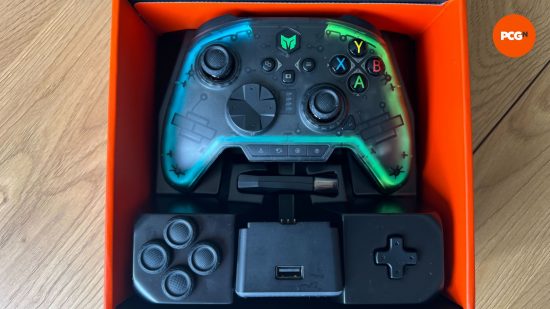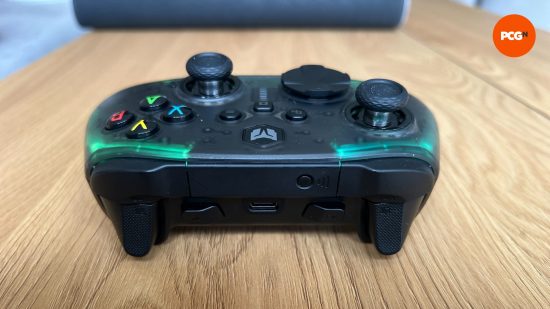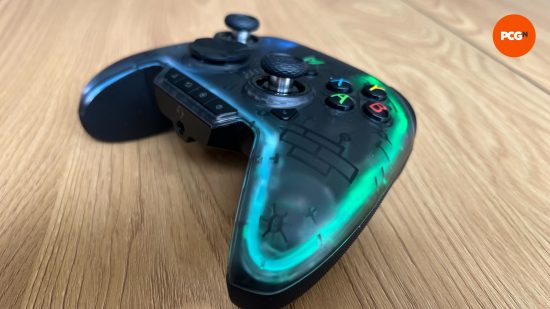Our Verdict
Stunning price, performance, and build quality all make the Rainbow Pro 2 shockingly good value against big brands like Turtle Beach, Nacon, and even Microsoft. Its visual design might make it look like a cheap off-brand controller to some, but thanks to how the whole package comes together, few controllers match it right now.
- Great value
- Long battery life
- Hall effect triggers
- Charging dock
- Incredibly tactile and responsive
- Design won't be for everyone
- M3 and M4 buttons are misplaced
The game controller market is getting out of hand, with multiple premium options pushing the $200 mark. This makes the Big Big Won Rainbow Pro 2 such a breath of fresh air. Not only is it reasonably priced, but you’re not sacrificing anything meaningful in the process unless you’re dead set on owning something with a more recognizable brand name
I’m surprised, but equally elated to say that the Rainbow Pro 2 is among the best PC controllers you can buy right now. From the responsive and adjustable hall effect triggers to the no-deadzone joysticks, there’s plenty to like about the Rainbow Pro 2, including its sub-$100 MSRP.
Why you can trust our advice ✔ At PCGamesN, our experts spend hours testing hardware and reviewing games and VPNs. We share honest, unbiased opinions to help you buy the best. Find out how we test.
Specs
| Connection | Bluetooth, 2.4GHz, and Wired |
| Power | Rechargeable 1000mAh battery |
| Platforms | PC, Nintendo Switch, Android, iOS |
| Layout | Xbox |

Features
The Rainbow Pro 2 doesn’t follow in the footsteps of other premium controllers, adding tertiary features like mini displays that have next to no impact on playing games, instead it focuses on nailing the basics to a degree where using the controller feels naturally more comfortable than the Xbox controller it is mimicking.
You’re getting a reliable wireless connection via 2.4GHz or Bluetooth, with wired play also possible. There is a 1000mAh battery that powers the controller and its already long life can be extended by turning down the RGB lighting brightness.
You also get additional thumbsticks, an 8-way d-pad, and an RGB charging dock, so that you can still keep your desktop looking classy when you need to charge your controller. It would have been nice to also have a case of some kind with the controller, but in line with keeping the overall cost down, I understand the decision not to include one.
You’ll control all the Rainbow Pro 2 features, including the four additional buttons and their bindings, via a mobile app. I did initially roll my eyes at the thought of this, but the app itself is quite intuitive and even features a full instruction manual should you require assistance and not have the paper version to hand.
You can connect to the controller via Bluetooth to access the mobile app features while still using it over 2.4GHz wireless, making changes to your profiles, the RGB lighting, or your key bindings while live in a game. This is something that I would try to actively avoid for the chaos it creates, but it’s certainly nice to know it’s possible.

Design
A frosted shell casing isn’t going to be to everyone’s taste, but paired with the muted RGB lighting, it actually works quite well. It’s a marked improvement over the Rainbow S, which sports a fully transparent shell, leading to the lighting overpowering the design and cheapening the look.
Everything else about the Rainbow 2 Pro is fairly straightforward, but rather than trying to revolutionize the Xbox controller layout, it leans heavily into an established formula. Where it differs is the placement of its four additional buttons. Two sit comfortably on the back of the controller, while the other two sit in between the trigger and shoulder buttons. I found myself accidentally activating them on odd occasions due to the way I hold a controller, meaning it effectively rules out using them for fear of it impacting gameplay.
The textured grip on the rear of each side of the controller is a welcome addition and isn’t so harsh that it collects grime from your hands as you play. A small protruding panel where the 3.5mm jack sits allows you to effectively cycle through the controller profiles and make quick adjustments on the fly. It doesn’t interfere with the grip of the Rainbow Pro 2 at all while also not looking out of place.
One point of contention I have with the design is the decision not to pursue hall effect joysticks. While not definitively proven to be faultless, yet, they are certainly showing to be far less prone to afflictions such as stick drift. Typical joysticks are also a potential liability due to the delicate nature of their structure versus the contact-free nature of the Hall Effect. It’s not a huge issue, but it is certainly worth considering.

Performance
The biggest praise I can heap upon the Rainbow Pro 2 is that it works seamlessly as a game controller, without a single dropped input recorded or a case of poor or laggy connection via Bluetooth or 2.4GHz wireless. I would argue that it feels better to use on PC than a standard Xbox controller too, thanks to the no-deadzone joysticks, Hall Effect triggers, and inclusion of the rear inputs, meaning the slight price difference is more than justified.
From the moment I first set up the controller, it worked, and it never stops working. After more than a month of heavy testing, the joysticks have held up well with no drift detected or calibration needed. No buttons have jammed or lost their feel and I can see this being the way for as long as I use the Rainbow Pro 2 as my primary controller.
All functions falling into a mobile app is a little annoying, but if you only ever plan to use the Rainbow 2 Pro as is, then fresh out of the box it’s still a fantastic PC controller that shows getting the basics right, and some under the bonnet hardware upgrades are worth investing in.
The battery life is enormous, with each full charge lasting in excess of 30 hours. It can sometimes be the case that when the battery runs low, connections and inputs are missed, but this isn’t the case with the Rainbow Pro 2, where the RGB runs red to warn of a low battery, but performance isn’t impacted in any way.
The changeable thumbsticks and d-pad are nice to have, and changing them is simple, but they don’t necessarily have any impact on the performance of the controller and instead are down to personal preference.
Final verdict
The Rainbow Pro 2 isn’t going to catch your eye with useless features that have no impact on your gaming experience, instead, it throws all its effort into creating a fantastic PC controller that works well, is built to last, and is priced fairly.
I would take it over a standard Xbox controller in a heartbeat, and it even beats out the Microsoft Elite for me largely because of how it suits my personal needs and I’m actually a fan of the overall visual design.
Price
The Rainbow Pro 2 has an MSRP of $79.99 (£79.99) for the version with the additional d-pad, thumbsticks, and charging dock, while just the controller is $64.99 (£64.99). Compared to premium offerings like the Turtle Beach Stealth Ultra or Nacon Revolution 5 Pro, this is incredible value. While these controllers target a higher price point, they actually fall short in some areas when compared, and the additional features that make up their value are often hard work to justify.
Alternatives
Microsoft Xbox Controller
Given that the Rainbow Pro 2 mimics the Xbox controller design so closely, it’s fair to say that if you’re okay dropping your extra buttons and RGB, there’s not a huge difference between the two on a surface level, and you can save a little cash by opting for Microsoft’s defacto controller.
I would, however, point out that the internal components that make up the overall better package of the Rainbow Pro 2 are well worth the added cost if budget isn’t a factor in your decision.
